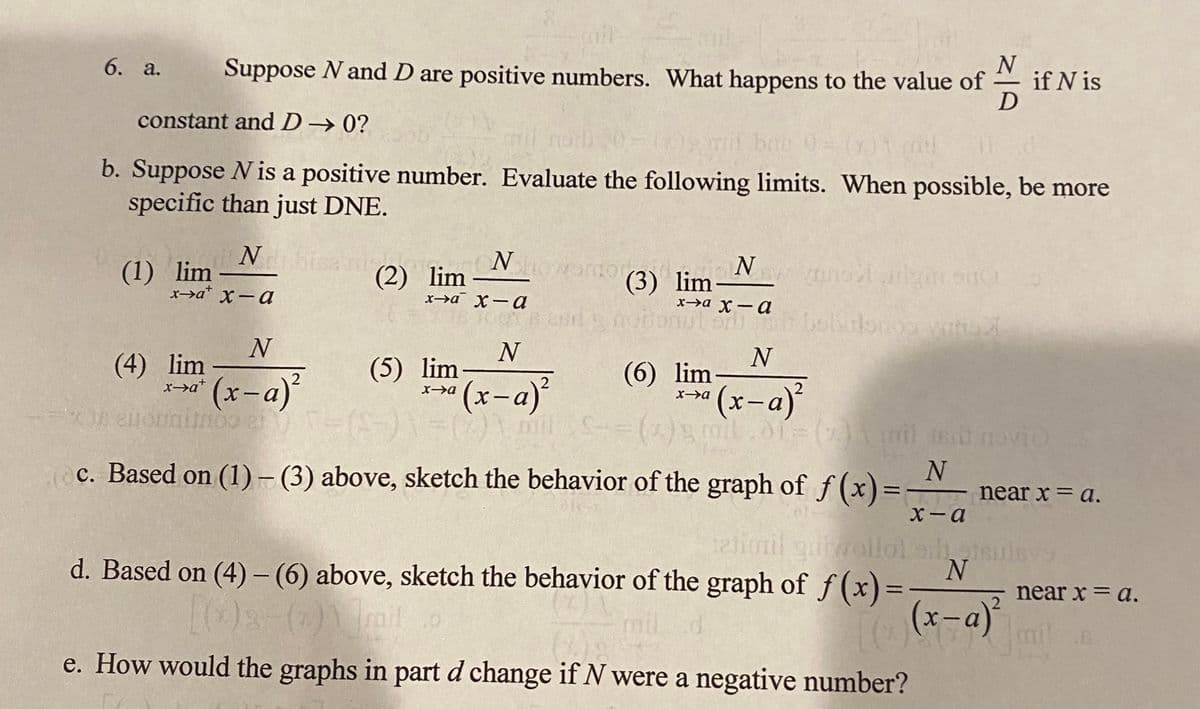6. а. Suppose N and D are positive numbers. What happens to the value of if N is constant and D→ 0? b. Suppose N is a positive number. Evaluate the following limits. When possible, be more specific than just DNE. (1) lim x»a* X-a N (2) lim x→a¯ X-a N lim x>a x-a fonut o (4) lim (x-a) (5) lim (x-a) N (6) lim :- c. Based on (1) - (3) above, sketch the behavior of the graph of f (x)= %3D near x = a. D-x etimil ga d. Based on (4)-(6) above, sketch the behavior of the graph of f(x)=- N near x = a. L(-a) e. How would the graphs in part d change if N were a negative number?
6. а. Suppose N and D are positive numbers. What happens to the value of if N is constant and D→ 0? b. Suppose N is a positive number. Evaluate the following limits. When possible, be more specific than just DNE. (1) lim x»a* X-a N (2) lim x→a¯ X-a N lim x>a x-a fonut o (4) lim (x-a) (5) lim (x-a) N (6) lim :- c. Based on (1) - (3) above, sketch the behavior of the graph of f (x)= %3D near x = a. D-x etimil ga d. Based on (4)-(6) above, sketch the behavior of the graph of f(x)=- N near x = a. L(-a) e. How would the graphs in part d change if N were a negative number?
Calculus: Early Transcendentals
8th Edition
ISBN:9781285741550
Author:James Stewart
Publisher:James Stewart
Chapter1: Functions And Models
Section: Chapter Questions
Problem 1RCC: (a) What is a function? What are its domain and range? (b) What is the graph of a function? (c) How...
Related questions
Question
A-E

Transcribed Image Text:6. a.
Suppose N and D are positive numbers. What happens to the value of
if N is
D
constant and D→ 0?
mit bao
b. Suppose N is a positive number. Evaluate the following limits. When possible, be more
specific than just DNE.
N
(1) lim
x→a* X-a
(2) lim
x>a X-a
(3) lim-
x→a X– a
N
(4) lim
x>a*
(5) lim
N
(6) lim
(x-a)
2
(x-a)
mil
2
(x-a)
x→a
1ovio
c. Based on (1) – (3) above, sketch the behavior of the graph of f (x)=
%3D
near x = a.
X- a
tatimil
go
ollol ate
d. Based on (4) -(6) above, sketch the behavior of the graph of f (x)%3D
near x a.
(x-a)°
mil
e. How would the graphs in part d change if N were a negative number?
Expert Solution
This question has been solved!
Explore an expertly crafted, step-by-step solution for a thorough understanding of key concepts.
This is a popular solution!
Trending now
This is a popular solution!
Step by step
Solved in 2 steps with 1 images

Recommended textbooks for you

Calculus: Early Transcendentals
Calculus
ISBN:
9781285741550
Author:
James Stewart
Publisher:
Cengage Learning

Thomas' Calculus (14th Edition)
Calculus
ISBN:
9780134438986
Author:
Joel R. Hass, Christopher E. Heil, Maurice D. Weir
Publisher:
PEARSON

Calculus: Early Transcendentals (3rd Edition)
Calculus
ISBN:
9780134763644
Author:
William L. Briggs, Lyle Cochran, Bernard Gillett, Eric Schulz
Publisher:
PEARSON

Calculus: Early Transcendentals
Calculus
ISBN:
9781285741550
Author:
James Stewart
Publisher:
Cengage Learning

Thomas' Calculus (14th Edition)
Calculus
ISBN:
9780134438986
Author:
Joel R. Hass, Christopher E. Heil, Maurice D. Weir
Publisher:
PEARSON

Calculus: Early Transcendentals (3rd Edition)
Calculus
ISBN:
9780134763644
Author:
William L. Briggs, Lyle Cochran, Bernard Gillett, Eric Schulz
Publisher:
PEARSON

Calculus: Early Transcendentals
Calculus
ISBN:
9781319050740
Author:
Jon Rogawski, Colin Adams, Robert Franzosa
Publisher:
W. H. Freeman


Calculus: Early Transcendental Functions
Calculus
ISBN:
9781337552516
Author:
Ron Larson, Bruce H. Edwards
Publisher:
Cengage Learning